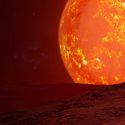Legend has it that somewhere beyond Neptune and Pluto, there is a ninth planet, with a mass that is five times greater than Earth’s. Planet Nine, also known by its more ominous name of Planet X, is shrouded in mystery. Some people even believe that this planet is the reason the dinosaurs died.
But what if we were able to close this case once and for all, and figure out if Planet Nine is the real deal? How did it get there in the first place?
And how did we finally crack this planetary puzzle? Let’s flashback to 1846, when we discovered Neptune. After this glorious find, scientists started wondering if there was another planet close by. Astronomer Percival Lowell then used calculations to predict a possible orbit and location of this planet.
In 1930, we thought we finally found it, but it was another planet called Pluto. You may have heard of it.
So, exactly what is supposed to be out there? Planet Nine is a hypothetical planet on the outskirts of our Solar System. The problem is that it’s located so far away, we might as well talk about where the Solar System ends, and what’s out there, which is another can of worms.
One theory is that Planet Nine formed at the same time as the other gas giants in our Solar System, Jupiter, Saturn, Uranus, and Neptune. And while little baby Planet Nine was feeding and growing (basically attracting gas from the gas disk in the Solar System,) it got too close to Jupiter’s gravity, and bounced out of the Solar System.
Because of this, Planet Nine could no longer absorb the gas it needed to continue growing, and ended up at a size of 5-15 times the mass of Earth. Another theory is that while the Sun was still growing inside its stellar nursery (aww baby Sun,) it might have captured an object from another star system residing within that nursery.
So in a sense, Planet Nine was kidnapped from another star system. Either way, there’s still a lot of speculation about how it got there, and even if it’s out there at all.
So, how would we get a closer look? Well, the thing about Planet Nine is that it’s all about the facts. For us to change our view of our very own neck of the woods, the Solar System, we have to have hard evidence.
The first way, and the luckiest, would be just to stumble across Planet Nine. Oh, there it is. Wham, bam, thank you, ma’am. Case closed.
But if it isn’t that easy, we’d have to embrace our inner sleuths and track it. We could potentially catch its trail by using TNOs, or Trans-Neptunian objects. They’re the frozen, rocky bodies floating around in the Kuiper Belt.
We recently found one dubbed FarOut, and to date, it’s the most distant object in the Solar System we’ve discovered. It’s located about 123 astronomical units (AU) away.
The goal is to identify as many TNOs as possible, as this will increase the chances of discovering Planet Nine. Sort of like following a trail of breadcrumbs leading us to this enigmatic planet.
The behavior of these TNOs suggests that there is a massive object out there on the outskirts of the Solar System, and it’s forcing these objects to assimilate.
Could it be Planet Nine? Well, here’s the thing. Sooner or later, we will find it if it exists.
Many studies are already underway, and more will start within the next few years. Astronomical sleuths will use everything from bigger and better telescopes, to faster and more powerful computers, to sift through all that data.
We’re discovering new cosmic objects all the time, so we may just find Planet Nine after all.
This isn’t the first time we’ve looked for something that some people didn’t think would exist. There may even be some undiscovered mysteries on our own planet.
Subscribe to What-If on YouTube or follow the show on Facebook Watch.
Sources
- “10 Things To Know About The Kuiper Belt – NASA Solar System Exploration”. Dyches, Preston. 2020. NASA Solar System Exploration.
- “In Pursuit Of Planet Nine”. 2020. astronomy.com.
- “Astronomers Discover 139 New Trans-Neptunian Objects”. 2020. sci-news.com
- “The Planet Nine Hypothesis”. Batygin, Konstantin, Fred C. Adams, Michael E. Brown, and Juliette C. Becker. 2019. Physics Reports 805: 1-53. doi:10.1016/j.physrep.2019.01.009.



























